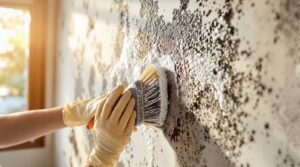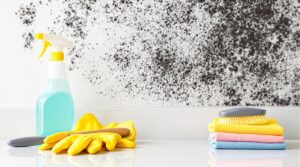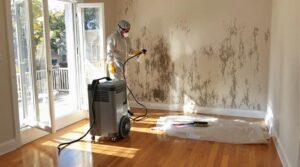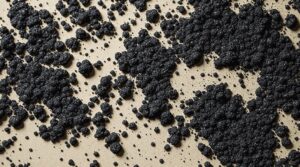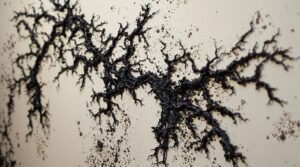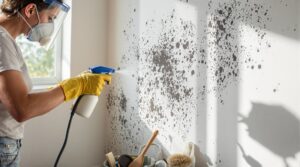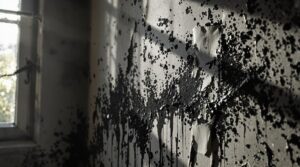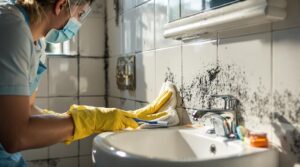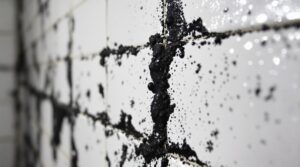Black mold on carpet can be effectively removed through a combination of proper cleaning techniques, improved ventilation, and moisture control. Wear protective gear, guarantee good ventilation, and prepare cleaning solutions to initiate removal. Utilize DIY methods such as baking soda and vinegar mixtures or anti-fungal sprays, and consider professional services for severe cases. By taking these steps, individuals can reduce health risks and eliminate mold. Further guidance on removal methods, prevention, and professional assistance is available. In addition to addressing mold on carpets, it’s essential to understand the methods for removing mold from wood floors, as wood can also harbor moisture that promotes mold growth. To clean wood surfaces, carefully scrub with a mixture of water and mild detergent, ensuring the area dries thoroughly afterward to prevent re-infestation. Regularly inspecting your home for signs of dampness and maintaining low humidity levels will further help safeguard your living environment from mold-related issues.
Key Takeaways
- Identify black mold on carpet through visual inspection, musty odors, and symptoms like sneezing and itchy eyes.
- Prepare for removal by wearing protective gear, ensuring good ventilation, and gathering cleaning solutions and tools.
- Use DIY methods like baking soda and vinegar mixtures, steam cleaners, or anti-fungal sprays to remove black mold.
- Consider hiring professional mold removal services for severe cases, using industrial-grade equipment and strict safety protocols.
- Prevent future mold growth by controlling moisture levels, inspecting carpets regularly, and addressing potential issues promptly.
Identifying Black Mold On Carpet
How does one determine if their carpet is infested with black mold? Visual inspection is essential, as black mold typically appears as patches that are black or dark green, often with a fuzzy or slimy texture.
However, mold growth often begins beneath the carpet surface, making it vital to inspect both visible and hidden areas. A distinct musty or earthy odor is a strong indicator of black mold presence, which may develop before the mold becomes visually apparent.
The presence of moisture is a key factor in mold growth, which can begin within 24-48 hours. Individuals exposed to black mold may exhibit symptoms such as sneezing, coughing, and itchy eyes, especially those with allergies or respiratory conditions.
To identify black mold on carpet, look for these signs and symptoms, paying attention to musty smells, moisture, and changes in the carpet's appearance. Early detection is essential for effective removal. The most dangerous type, Stachybotrys atra, produces harmful mycotoxins that can cause severe health complications.
Causes And Growth Of Black Mold
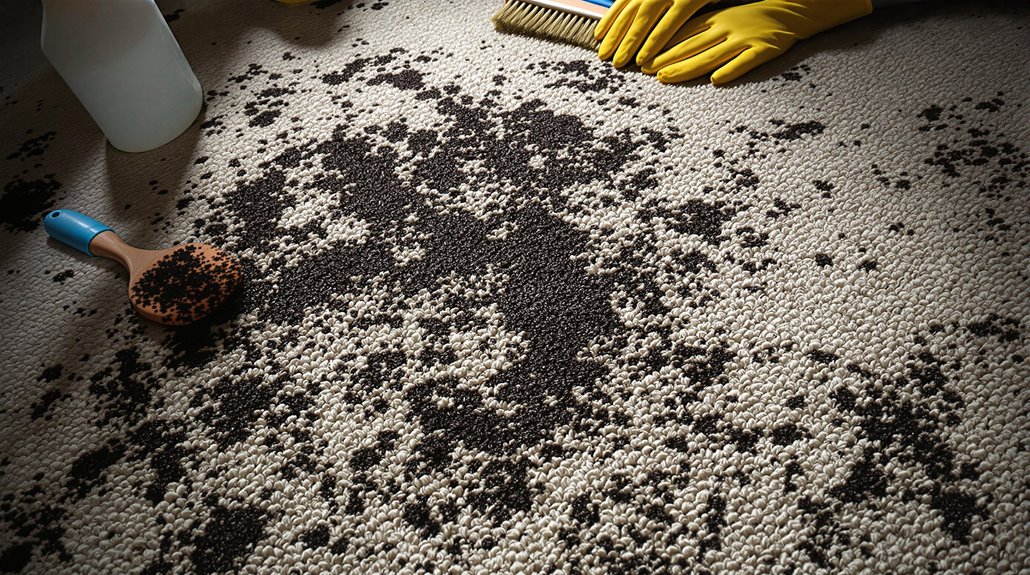
Black mold growth on carpet is facilitated by the presence of moisture, which can be introduced through various means, including flooding, leaks, or high humidity.
Carpets in damp areas, such as basements and bathrooms, are particularly susceptible to mold growth due to their ability to retain moisture.
When moisture is present, mold spores can germinate and proliferate within 24-48 hours, especially in carpets with thick, woven materials that can absorb and retain moisture.
The development of toxic black mold in carpets can release dangerous mycotoxins that affect neurological function and cause severe respiratory issues.
Mold Growth Conditions
When carpeted areas are exposed to excessive moisture, the resultant damp environment fosters an ideal breeding ground for mold growth. High humidity levels, typically above 50%, contribute considerably to the likelihood of black mold growth on carpets. The average family produces approximately 4 gallons of moisture daily through regular household activities.
| Conditions for Mold Growth | Description |
|---|---|
| Excessive Moisture | Damp environments foster mold growth |
| Organic Materials | Carpet fibers provide necessary nutrients |
| Poor Ventilation | Stagnant air allows mold spores to settle |
| High Humidity | Levels above 50% create ideal conditions |
| Accumulated Dust | Traps moisture, facilitating mold growth |
To prevent future mold infestations, it is essential to maintain optimal moisture levels and guarantee good ventilation in carpeted areas. Regular cleaning and inspecting of carpet fibers can also help identify potential issues before they escalate into full-blown mold growth.
Common Breeding Grounds
Damp environments, such as those found in basements and bathrooms, serve as fertile breeding grounds for black mold growth.
The presence of high humidity and moisture in these areas creates an ideal habitat for mold spores to germinate and thrive.
Carpets, in particular, retain moisture from spills, flooding, or high humidity, making them susceptible to mold infestation within 24-48 hours under suitable conditions.
High-traffic areas with dust and organic matter buildup provide nutrients for mold, increasing the likelihood of infestation.
Flooded areas are also prone to black mold growth if moisture is not promptly addressed.
Wet carpets can harbor mold spores that can spread rapidly if left untreated, emphasizing the importance of prompt action to prevent mold growth on carpets.
The dangerous Stachybotrys black mold typically appears as slimy pitch-black growths that can cause severe respiratory issues and memory problems if not properly remediated.
Health Risks Associated With Black Mold
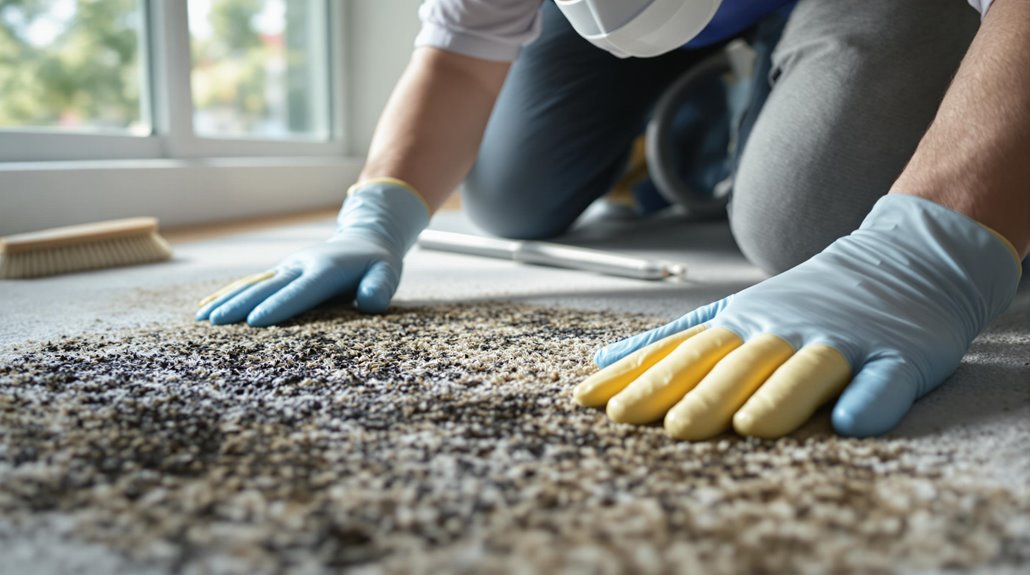
Exposure to black mold poses significant health risks, ranging from mild allergic reactions to severe respiratory and neurological issues.
Individuals may experience symptoms such as coughing, sneezing, and itchy eyes, with those having pre-existing health conditions being at a higher risk of developing serious complications.
Understanding the severity of health issues caused by black mold and learning about mold exposure symptoms are essential for preventing mold-related illnesses.
Those with compromised immune systems face heightened risks of developing chronic fatigue, persistent sinus infections, and brain fog from black mold exposure.
Severity of Health Issues
Numerous health issues can arise from black mold exposure, with respiratory problems being a primary concern. Mold spores can cause skin irritations, rashes, and allergic reactions, leading to symptoms such as sneezing, runny or stuffy nose, and itchy or watery eyes in sensitive individuals.
Exposure to black mold can also lead to chronic fatigue, headaches, and in severe cases, memory loss or difficulty concentrating. The EPA has identified mycotoxins released by black mold as potentially toxic substances that can affect the immune system and cause neurological issues.
Vulnerable populations, such as young children, the elderly, and those with pre-existing health conditions, are at a greater risk of experiencing severe health complications from mold exposure. Prolonged exposure can exacerbate existing conditions and lead to more severe health issues. People exposed to water-damaged buildings often experience cognitive dysfunction symptoms including brain fog, impaired memory retention, and reduced attention span.
Mold Exposure Symptoms
Several notable health risks are associated with black mold, primarily stemming from the release of allergens and mycotoxins as the mold grows and spreads. Prolonged mold exposure can lead to respiratory infections, asthma exacerbation, and allergic reactions.
Individuals with compromised immune systems or pre-existing respiratory conditions are at higher risk for health complications.
Common symptoms of mold exposure include:
- Throat irritation and sneezing
- Coughing and skin rashes
- Itchy, watery eyes in sensitive individuals
- Severe allergic responses and respiratory problems in susceptible populations
If symptoms worsen or signs of more severe reactions occur, such as persistent coughing or difficulty breathing, immediate medical attention may be required to mitigate the health effects of mold exposure.
Extended exposure to black mold can cause organ damage particularly affecting the liver and gastrointestinal system.
Preventing Mold Illness
The health risks associated with black mold can be mitigated by understanding the factors that contribute to its growth and taking proactive measures to prevent exposure.
To prevent mold illness, it is essential to control moisture levels, as mold spores thrive in damp environments. Immediate action to remove mold and address moisture issues is vital, as delaying treatment can result in more severe health effects and long-term damage to both the home and its occupants.
Regularly inspecting for signs of mold and addressing any water damage promptly can help prevent mold growth. By taking these steps, individuals can reduce their exposure to mold spores and minimize the risk of developing mold-related health issues.
Effective prevention and removal strategies can greatly mitigate the health risks associated with black mold.
Preparing For Black Mold Removal
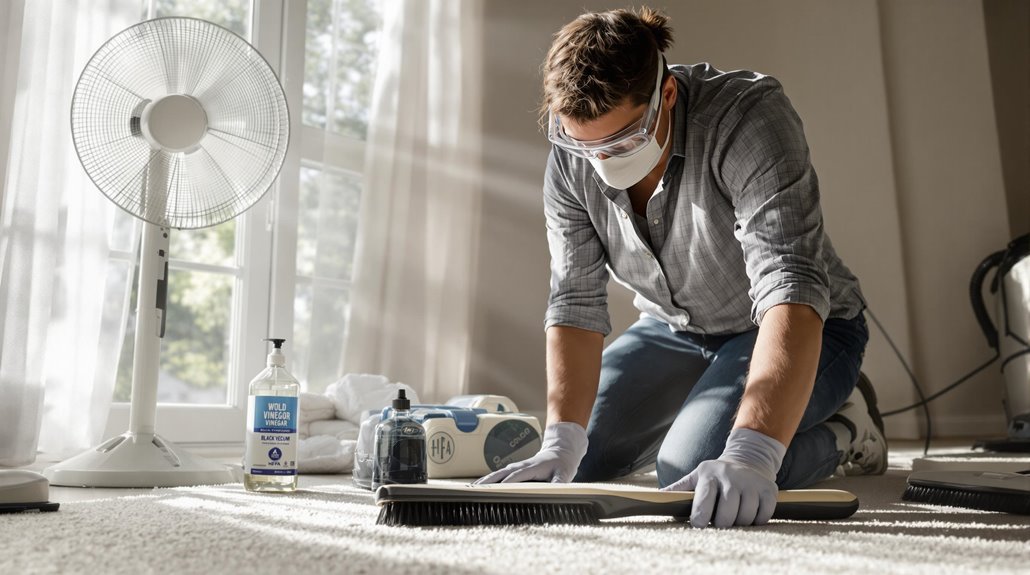
Before attempting to remove black mold from carpet, it is vital to prepare the area and oneself to secure a safe and effective cleanup process.
Preparing for black mold removal involves taking necessary precautions to prevent exposure to mold spores and guarantee thorough removal of the mold. The following steps are essential in preparing for black mold removal:
- Wear protective gear such as masks, gloves, and goggles to prevent exposure to mold spores.
- Maintain good ventilation in the area by opening windows or using fans to help disperse mold spores and reduce humidity levels.
- Prepare cleaning solutions, such as a mixture of white vinegar and water or anti-fungal sprays, to effectively treat the mold on the carpet.
- Gather necessary cleaning tools, including a stiff bristle brush, HEPA vacuum, and towels, to facilitate thorough removal of mold and secure a safe cleanup process.
DIY Methods For Removing Black Mold
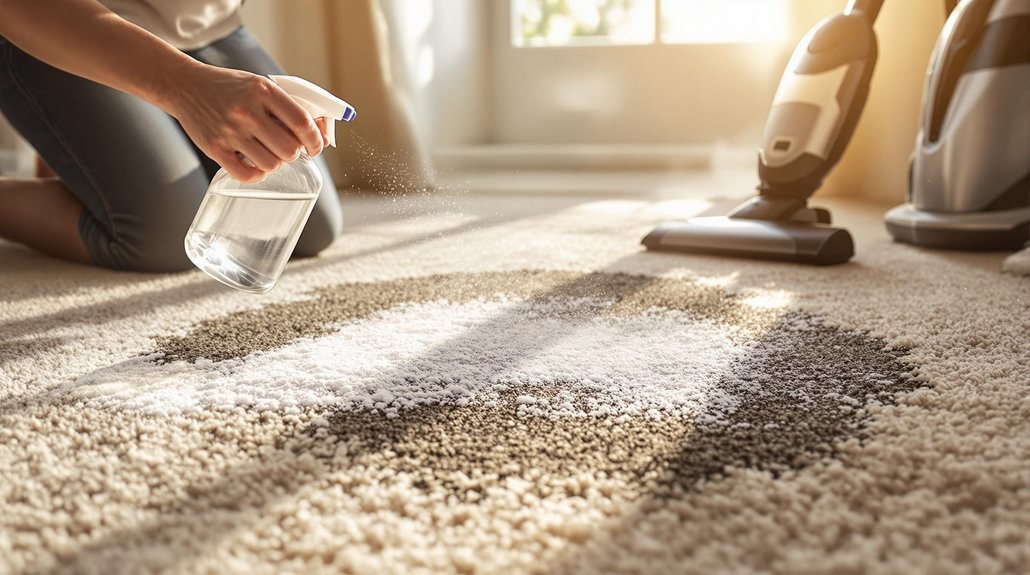
Following proper preparation, removal of black mold from carpet can be effectively achieved through various DIY methods.
A mixture of baking soda and white vinegar can be applied to the affected area, with the baking soda applied first and then sprayed with vinegar to scrub the area clean.
When using a steam cleaner, the heat should be applied for at least 12 seconds to effectively kill mold spores, and the carpet thoroughly dried afterward to prevent regrowth.
Anti-fungal sprays specifically designed for carpets can also be applied.
After initial cleaning, a HEPA vacuum cleaner can be utilized to filter out remaining mold spores.
Effective removing mold through DIY methods requires attention to detail and thorough execution.
If the mold issue persists, it may be necessary to contemplate hiring professional carpet cleaners who possess the expertise and specialized equipment necessary for thorough and effective mold removal.
Professional Black Mold Removal Services

Employing professional black mold removal services is a viable option for homeowners struggling to eradicate mold from their carpets. These services utilize industrial-grade equipment to effectively eliminate mold spores and prevent regrowth in carpets and surrounding areas.
Key benefits of hiring professional mold removal services include:
- Thorough assessments of mold damage to address both visible and hidden mold
- Strict safety protocols to protect against health risks associated with mold exposure
- Assured work to provide peace of mind that the mold will be effectively removed
- Expertise and resources to handle extensive mold issues and minimize future growth
Professional carpet cleaning services can also help regulate moisture levels, an essential factor in preventing mold growth.
Preventing Future Black Mold Growth
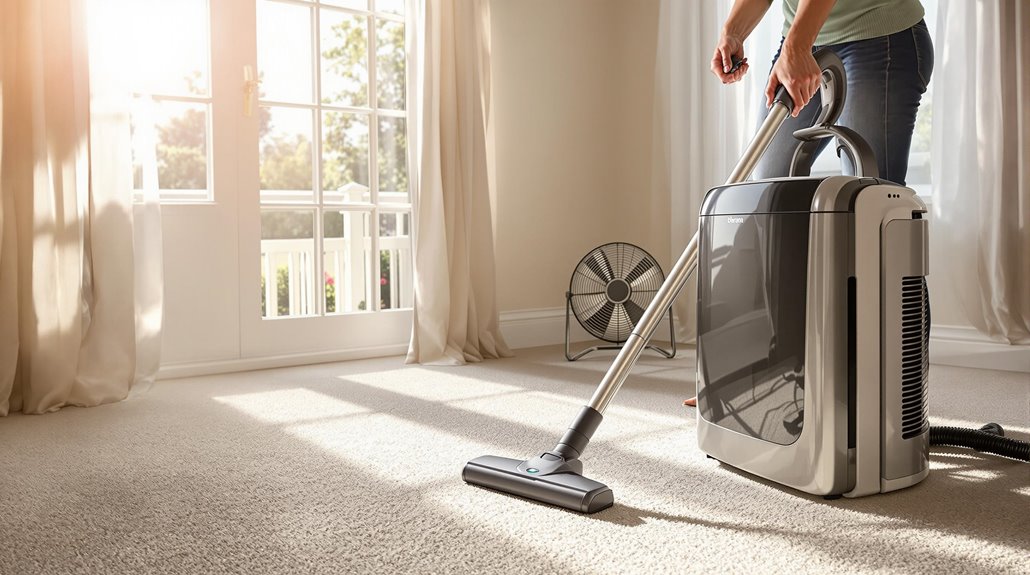
While professional mold removal services can effectively eradicate mold spores, preventing future growth is vital to maintaining a clean and healthy carpet.
Preventing future black mold growth requires a combination of strategies that address the underlying conditions that foster mold development. One key step is to maintain indoor humidity levels between 30% to 50% by using a dehumidifier in areas prone to moisture accumulation.
Keeping moisture levels in check can be achieved by ensuring good ventilation in carpeted areas through the use of fans and opening windows. Regular vacuuming with a HEPA filter and promptly addressing spills or leaks are also essential steps to prevent mold growth.
By implementing these measures, individuals can create an environment that is less conducive to mold development, thereby preventing future black mold growth and maintaining a clean and healthy carpet.
Effective prevention relies on consistent and proactive efforts to manage moisture and humidity.
Effective Cleaning And Maintenance Techniques
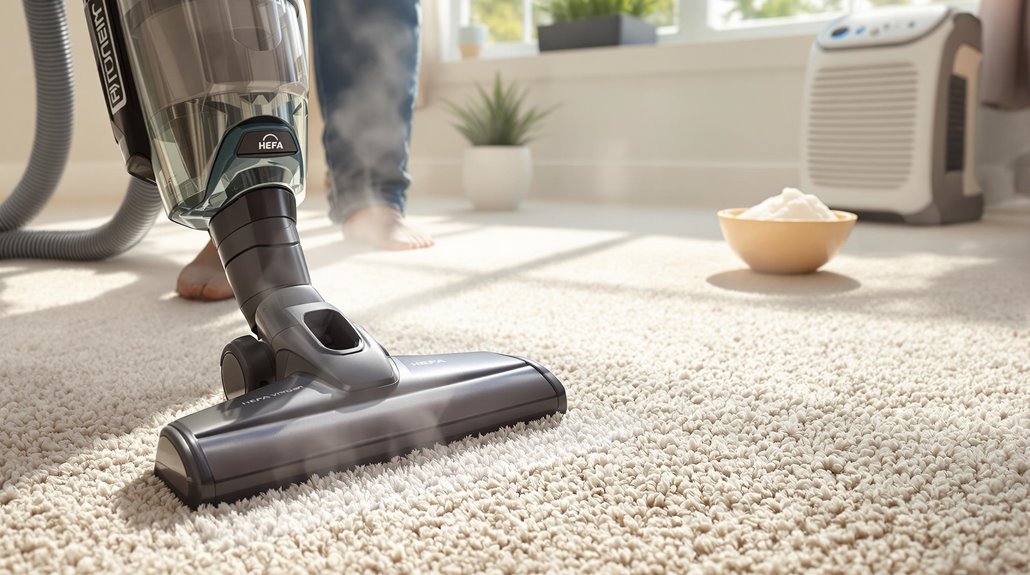
Implementing effective cleaning and maintenance techniques is essential in preventing black mold growth on carpets. Black mold needs specific conditions to grow and thrive, including moisture, organic materials, and ideal temperatures. Keeping moisture levels between 30% to 50% with dehumidifiers can create an inhospitable environment for mold spores.
- Utilizing HEPA vacuums to filter out mold spores effectively and remove dust and organic materials.
- Ensuring prompt action to address any spills or leaks by drying the affected area thoroughly.
- Applying a baking soda and white vinegar mixture as a natural cleaning method, allowing the baking soda to absorb odors and the vinegar to kill mold spores.
- Regularly steam cleaning carpets, applying heat for at least 12 seconds, and drying immediately, can also help to remove mold and prevent future growth, consequently potentially reducing the need for professional Carpet Cleaning.
The Benefits Of Consulting A Public Adjuster
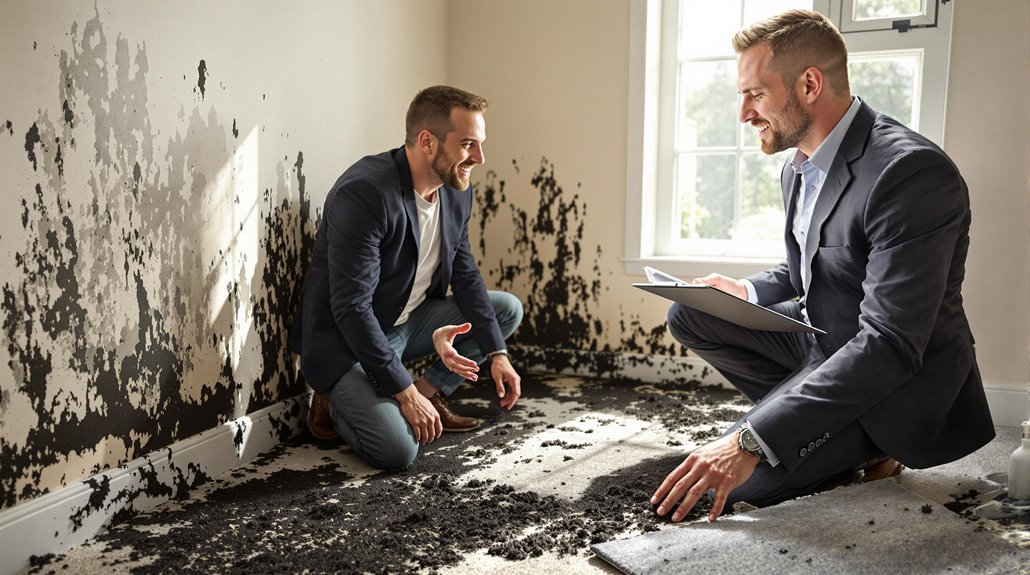
In situations where mold damage necessitates insurance claims, consulting a public adjuster can provide policyholders with essential expertise.
One key benefit of partnering with a public adjuster is access to objective damage assessment, facilitating a more streamlined claim process and alleviating the demands of dealing with the insurance company.
Expertise In Insurance Claims
Property owners dealing with mold damage on their carpets often face an intimidating task when maneuvering through the complexities of insurance claims.
Consulting a public adjuster can provide expertise in managing these claims.
Some benefits of working with a public adjuster include:
- Expert documentation of mold damage and necessary repairs to strengthen your case
- Negotiation with insurance companies on your behalf to save time and reduce stress
- Alignment of interests, as public adjusters only get paid if you win your claim
- Potential increase in chances of receiving coverage for preventative measures and mold remediation efforts
Objective Damage Assessment
One critical aspect of effectively addressing mold damage on carpet involves conducting an objective damage assessment. Consulting a public adjuster can facilitate this process by providing a detailed evaluation of the affected areas. They identify hidden mold growth and potential structural damage, guaranteeing accurate damage assessments and extensive insurance claims.
| Benefits of Consulting a Public Adjuster | Impact on Mold Damage Remediation |
|---|---|
| Accurate damage assessments | Guarantees extensive remediation efforts |
| Access to specialized tools and resources | Facilitates detailed evaluation of mold damage |
| Valuable documentation and evidence | Supports effective insurance claims and compensation |
Streamlined Claim Process
Numerous benefits arise from consulting a public adjuster when dealing with mold damage on carpet, particularly regarding streamlining the claim process. A public adjuster can efficiently manage the entire claims process, ensuring that all relevant damages are accurately documented and reported to the insurance company.
Some key benefits of working with a public adjuster include:
- Ensuring accurate documentation of mold damage to support insurance coverage
- Expert negotiation with insurance companies to secure a fair settlement
- Assistance maneuvering through policy complexities to understand coverage and entitlements
- Ability to focus on recovery and remediation efforts while the public adjuster handles the claims process
Higher Claim Payouts & Settlements
When dealing with mold damage on carpet, consulting a public adjuster can greatly impact the outcome of the claims process, particularly regarding securing higher claim payouts and settlements.
Public adjusters possess expertise in maneuvering through complex insurance policies, ensuring all damages, including hidden mold issues, are thoroughly documented and assessed. This expertise typically leads to settlements that are 20-50% higher than those offered by insurance companies.
By advocating specifically for the policyholder's interests, public adjusters can maximize coverage for mold remediation and related damages, including water damage.
Ultimately, engaging a public adjuster can lead to improved outcomes in claims, saving homeowners time and stress, and providing access to resources and knowledge that may otherwise be unavailable.
This results in higher claim payouts and more thorough settlements.
About The Public Claims Adjusters Network (PCAN)
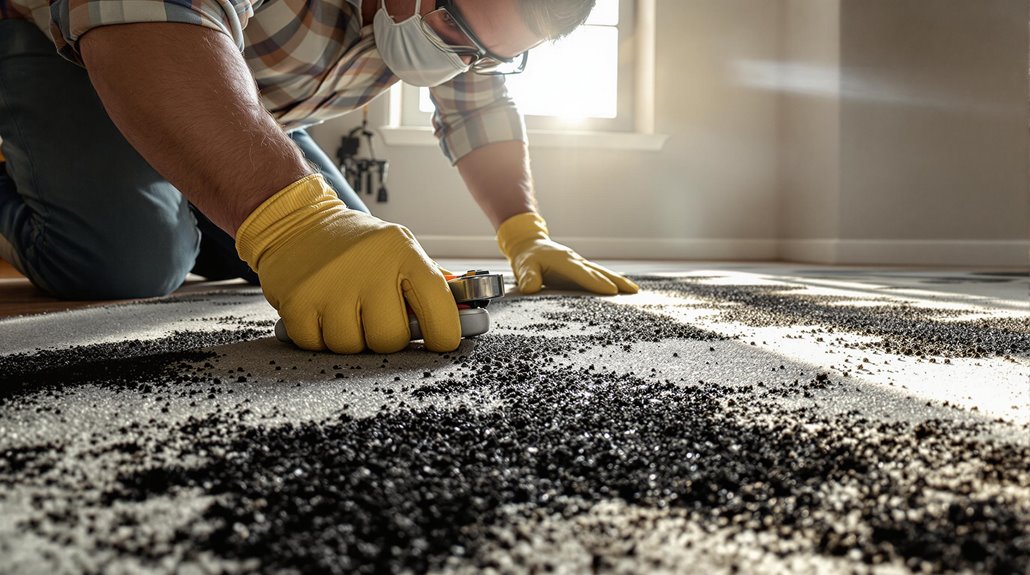
The Public Claims Adjusters Network (PCAN) is a nationwide organization that connects policyholders with top-tier, pre-vetted public adjusters.
PCAN serves as a trusted resource for individuals seeking expert guidance on property damage insurance claims, including those related to mold damage on carpet flooring.
PCAN member adjusters specialize in residential and commercial claims, covering over 30 different claim types.
Key benefits of working with PCAN public adjusters include:
- Expertise in resolving mold problems and preventing moisture levels from reaching critical points
- Assistance with maneuvering through complex insurance claims processes
- Thorough assessments of property damage, including mold from your carpet
- Efficient communication and negotiation with insurance providers to secure higher claim payouts and settlements.
By working with a PCAN public adjuster, policyholders can rest assured they are receiving expert guidance and support throughout the claims process.
This can be invaluable when dealing with costly mold damage on carpet flooring.
Frequently Asked Questions
Can You Remove Black Mold From Carpet?
Black mold removal from carpet is feasible with effective carpet cleaning methods and prompt action. Applying mold prevention tips can minimize health risks. However, extensive infestations may require professional services for complete elimination.
Can Moldy Carpet Be Saved?
Moldy carpet can be saved with prompt treatment using carpet cleaning solutions and home mold remedies, such as vinegar and baking soda. Regular mold prevention tips and professional cleaning services can also aid in recovery, or consider carpet replacement options.
Does Vinegar Kill Mold in Carpet?
As the battle against mold wages on, a pressing query emerges: does vinegar kill mold in carpet? Indeed, vinegar's effectiveness shines in carpet cleaning, leveraging its acidic properties to execute mold removal with remarkable proficiency among home remedies.
Will Lysol Kill Mold in Carpet?
Lysol can kill surface mold on carpets, but its effectiveness is limited by its inability to penetrate deep into carpet fibers. Spray application can aid in carpet cleaning and mold prevention as part of regular carpet maintenance.
